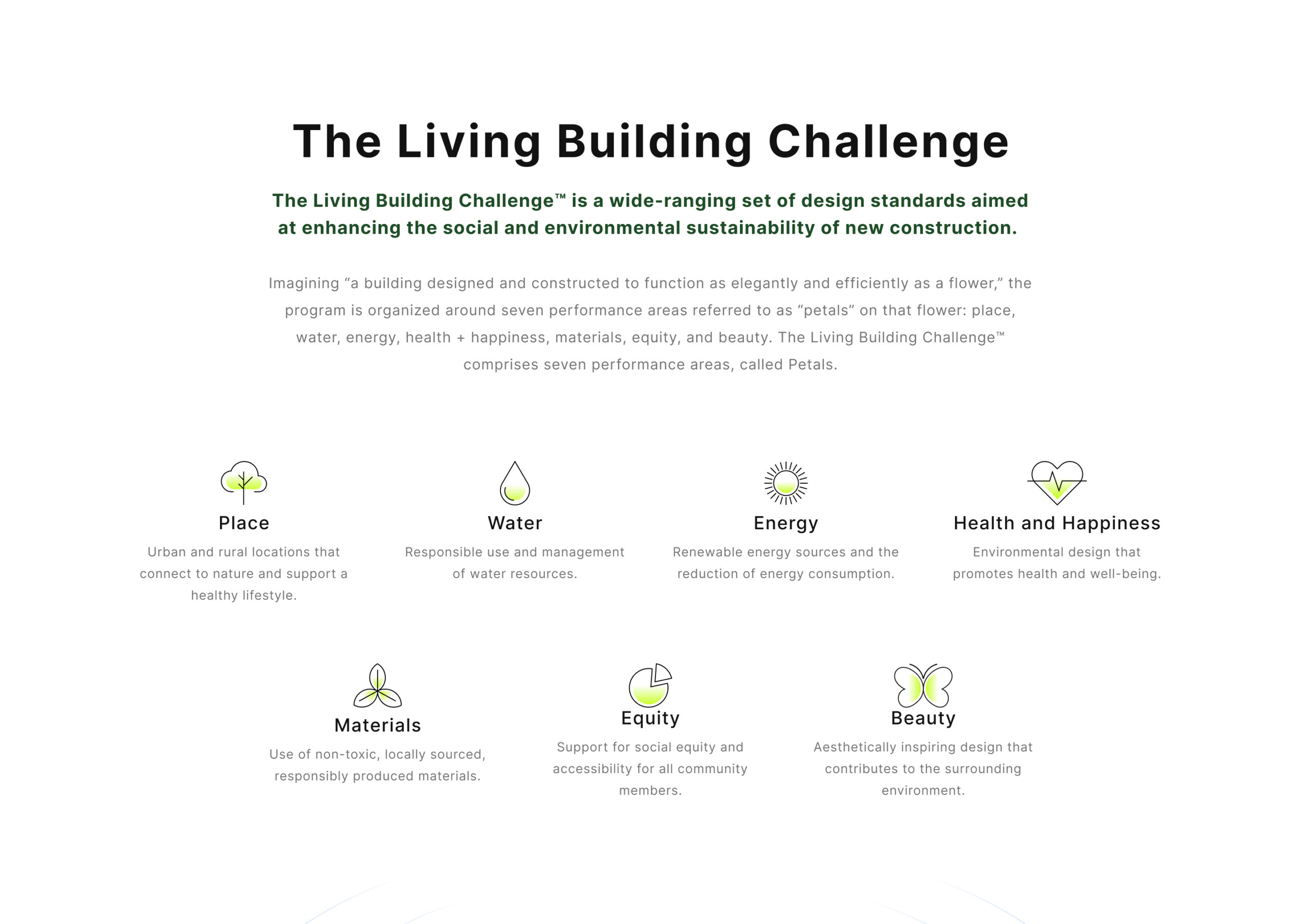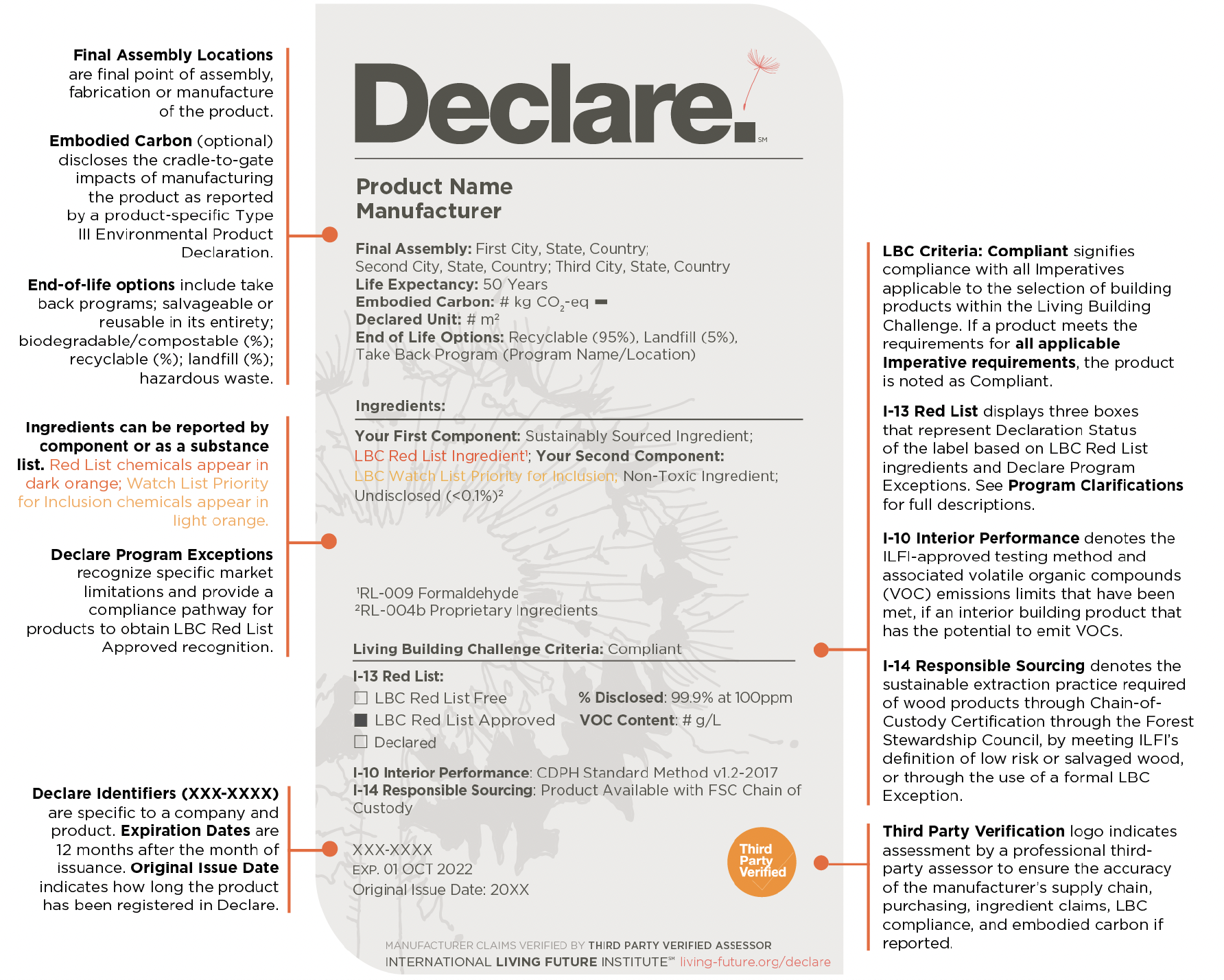A Guide to Declare Standards
A Guide to Declare Standards and How They Relate to LED Fixtures and Drivers
Declare labels can help lighting manufacturers identify materials that comply with green building standards
Social awareness and sustainability efforts are now an integral part of the landscape for most municipal and government development projects. Many municipalities provide incentives to encourage new construction to meet the parameters of the Living Building Challenge (LBC), a green building initiative started by the International Living Future Institute (ILFI) in 2006.
But identifying materials and components that comply with the LBC’s requirements can be difficult. Ultimately, the responsibility falls on architects, planners, designers and specifiers to ensure that new construction projects meet these strict guidelines. And in turn, these professionals rely on the manufacturers of the products they source, and tools like LBC’s Declare program, to help them identify compliant resources.
This article is a primer on the Declare program, part of ILFI’s Living Building Challenge. It explains the program’s purpose and standards, its labeling protocol, how you can apply for certification, and how Hatch Lighting products can help you meet the requirements for certification.
LED Drivers cannot be Declare certified on their own. Only a completed fixture can be certified. But an LED driver can be added to the “Ingredients” section of a Declare label as long as it’s RoHS compliant, which all Hatch products are. Thus any Hatch product can be used as an approved component in a Declare certified lighting fixture.
Please read below for complete details on how Declare works and the steps required to get your fixtures Declare certified.

Source: living-future.org/lbc
What Is Declare Certification?
Declare is a voluntary self-disclosure program detailing the chemical composition of construction products. It’s designed to encourage:
- Product transparency – By requiring manufacturers to disclose the chemical ingredients and materials they use, Declare helps lighting engineers and fixture designers select materials that align with their sustainability goals.
- Responsible material sourcing – Declare encourages engineers to prioritize products that are made from locally available, non-toxic, and sustainably harvested materials, promoting a more environmentally friendly and socially responsible approach to construction.
What Is a Declare Label?
The Declare label is like “a nutrition label for building products.” It identifies every intentionally added component chemical at or above 100 ppm (.01%). Products that have been registered with the program are eligible for a listing in the ILFI Declare database. This broad database consists of building materials, flooring, windows, furniture, fixtures – including lighting fixtures – and all other elements and materials that comprise a physical building. By applying for and obtaining a Declare label and a listing in the LBC Declare database, fixture manufacturers are visible to specifiers looking for products that help them meet required LBC parameters.
The listings for most products are self-disclosed, so engineers should seek out products that have been recognized by the Declare program to verify their compliance with the standards. There’s also an optional program for products to receive independent certification through third party assessors approved by the ILFI – products that receive this extra level of certification will have an additional element indicating such in the lower right hand section of their Declare label.
What Is The Declare Red List?
The Red List is a key component of the program. It details a list of chemicals and materials that are restricted or prohibited due to their negative impacts on human health or the environment. Consulting the Red List can help lighting engineers avoid the use of these materials in their designs.
There are three different Declare statuses a product can be given depending on its level of compliance with the LBC Red List. Those statuses are:
- LBC Red List Free – products that disclose 100% of their components at or above 100 ppm and don’t contain any Red List chemicals.
- LBC Red List Approved – products that disclose at least 99% of their components and meet the LBC Red List requirements through one or more approved exceptions.
- LBC Compliant – products that disclose 100% of their components and contain one or more Red List chemicals not covered under any exception.
The Red List is updated every year, usually in January. There’s also a Watch List of chemicals and compounds that have been identified as likely candidates for inclusion on the Red List in the future. Both of those lists, which identify components by their CAS Registry Number, are available here.
How Do Hatch Lighting Products Help You with Declare Certification?
Sustainable lighting fixture design is an important component of the environmental stewardship the Declare standards help to foster. By choosing components that are listed in the Declare database, lighting engineers can:
- Design energy-efficient lighting technologies.
- Reduce the emission of harmful chemicals for better indoor air quality.
- Safeguard the health and well-being of building occupants.
- Help reduce the overall environmental impact of lighting systems.
Declare labels are only offered for completed lighting fixtures, so individual fixture components such as LED drivers cannot be Declare labeled on their own. However, individual components can contribute to Declare labeling for the lighting fixtures that include them. Components like Hatch’s Foundation Series LED drivers can be listed in the “Ingredients” section of the Declare label for light fixtures.
Red List Approved Exceptions
In the “Ingredients” section of the Declare label there‘s an area for exceptions. Declare makes allowance for several exceptions to be taken with respect to materials.
For fixture manufacturers one of the most significant exceptions is RL-002b, Small Electrical Components. This exception covers electronic components including drivers, auxiliary power supplies, and communication modules. All that is required to be able to utilize this exception is that the electronic modules meet RoHS requirements.
Hatch Lighting designs and manufactures a wide variety of power supplies, electronic transformers, ballasts, and LED drivers specifically focused on meeting the needs of lighting manufacturers. All Hatch products are RoHS and REACH-compliant, to help make your Declare label submissions using the RL-002b exception straightforward.

How Do I Get My Fixture Listed in the Declare Database?
A fixture manufacturer that wants to get their product listed in the Declare database must be granted a Declare label. Those are issued by the ILFI. Let’s walk through the process.
- Create an ILFI member account.
- Create a Toxnot account and link it to your ILFI account. Toxnot is a cloud-based database used by ILFI to validate the materials list of a product. In this database, account holders can upload entire bills of materials for specific products. This populates the Declare label.
- After paying the label fee, ILFI will review your entry to ensure it complies with submission requirements. Once approved, ILFI will share the Declare label with the manufacturer for final review.
- Publish! Once the manufacturer approves the label it will get published in the ILFI’s Declare database. This will allow specifiers and designers to see your product and meet their directives for LBC and WELL building initiatives.
Leaders in Sustainable Manufacturing
The Living Building Challenge and the Declare certification program set a standard for more accessible, sustainable construction. Lighting fixture manufacturers can choose components like Foundation Series LED Drivers from Hatch to design lighting solutions that are compliant with Declare and that help architects, planners, designers, and specifiers contribute to healthier, more sustainable buildings – and a greener future for everyone.
Call us at 813-288-8006 or contact us online to learn about our commitment to environmental sustainability and to find out more about how Hatch Lighting products can enhance your next lighting fixture production.